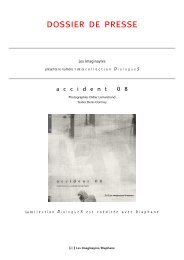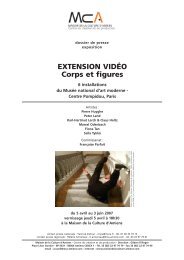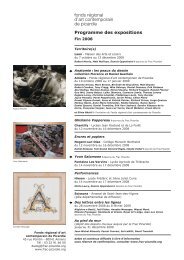Catalogue - Arts plastiques
Catalogue - Arts plastiques
Catalogue - Arts plastiques
You also want an ePaper? Increase the reach of your titles
YUMPU automatically turns print PDFs into web optimized ePapers that Google loves.
Reformuler la question<br />
Pages précédentes : “Handle” 2007-2008, céramique peinte. Globe Gallery, Newcastle upon Tyne - Détails de “Wall drawing liquide” 2008, céramique, craie, plastique<br />
Si je vous demande combien vous avez de doigts, il est probable que vous répondiez “cinq”. Ceci, je crois,<br />
constitue une réponse erronée. A mon sens, la réponse correcte est “Gregory, vous posez cette question<br />
de la mauvaise manière”. Pendant le processus de croissance humain, il n’y a assurément aucun mot qui<br />
signifie doigt et aucun mot qui signifie cinq. Il se pourrait qu’il y ait un mot pour “ramification”, une<br />
commande quelconque qui identifie les contingences de ramification. Si c’est le cas, alors la question<br />
correcte serait : combien de relations entre paires de doigts avez-vous ? Et la réponse correcte est, bien<br />
entendu, quatre. La relation entre un et deux, la relation entre deux et trois, entre trois et quatre, quatre<br />
et cinq. (Il est improbable, je pense, que la relation entre le numéro quatre et le numéro cinq ait rétroagi<br />
sur la relation entre un et deux, quoique concevable).<br />
Vous devriez compter non pas les choses qui sont liées, mais les liaisons, non les relata, mais les relations.<br />
Combien de ramifications a-t-il fallu pour faire une main ? Et non combien de doigts ont résulté d’une telle<br />
ramification.<br />
Regardez votre main à présent et essayez de saisir la différence entre la main en tant que base pour cinq<br />
parties et la main en tant que construction d’un noeud de relations. Pas un noeud, un schéma renfermant<br />
les enchaînements des relations qui furent les déterminants de sa croissance. Et si vous pouvez réellement<br />
arriver à voir la main selon l’épistémologie que je propose, je pense que vous réaliserez que votre main est<br />
soudain évidemment bien plus belle en tant que produit d’une relation qu’en tant que composition d’une<br />
somme de parties. En d’autres termes, je suggère, premièrement, que le langage est très trompeur et,<br />
deuxièmement, que si vous commencez même sans beaucoup de connaissances à vous lancer dans<br />
l’aventure de concevoir ce que ce serait de regarder le monde avec une épistémologie biologique, vous<br />
entrerez en contact avec des concepts que les biologistes ne considèrent absolument pas. Vous<br />
rencontrerez la beauté et la laideur. Il se peut que ces dernières soient de réelles composantes du monde<br />
dans lequel vous vivez, en tant que créature vivante.<br />
Rephrasing the question<br />
Gregory Bateson “Dernière Conférence” ICA Londres, le 28 Octobre 1979.<br />
If I ask you how many fingers you have, you will probably answer, “Five”. That I believe to be an incorrect<br />
answer. The correct answer, I believe, is “Gregory you are asking a question wrongly”. In the process of<br />
human growth, there is surely no word which means finger, and no word which means five. There might be<br />
a word for “branching”, a command of some sort identifying the contingencies of branching. If that is so, then<br />
the right question would be : How many relations between pairs of fingers do you have ? And the correct<br />
answer, of course, is four. The relation between one and two, the relation between two and three, between<br />
three and four, four and five. (It is unlikely, I think, that the relation between number four and five acted back<br />
upon the relation between one and two - but conceivable).<br />
You should be counting not the things which are related, but the relationships; not the relata, but the<br />
relationships. How many branchings did it take to make a hand ? Not how many fingers were a result of such<br />
branchings.<br />
Look at your hand now… And try to catch the difference between seeing it as a base for five parts and<br />
seeing it as constructed of a tangle of relationships. Not a tangle, a pattern of the interlocking of relationships<br />
which were the determinants of its growth. And if you can really manage to see the hand in terms of the<br />
epistemology that I am offering you, I think you will find that your hand is suddenly much more recognizably<br />
beautiful as a product of relationship than as a composition of countable parts. In other words I am suggesting<br />
to you, first, that language is very deceiving, and, second, that if you begin even without much knowledge<br />
to adventure into what it would be like to look at the world with a biological epistemology, you will come<br />
into contact with concepts which the biologists don’t look at all. You will meet with beauty and ugliness.<br />
These may be real components in the world that you as a living creature live in.<br />
Gregory Bateson “Last Lecture” Delivered at the ICA London October 28, 1979








